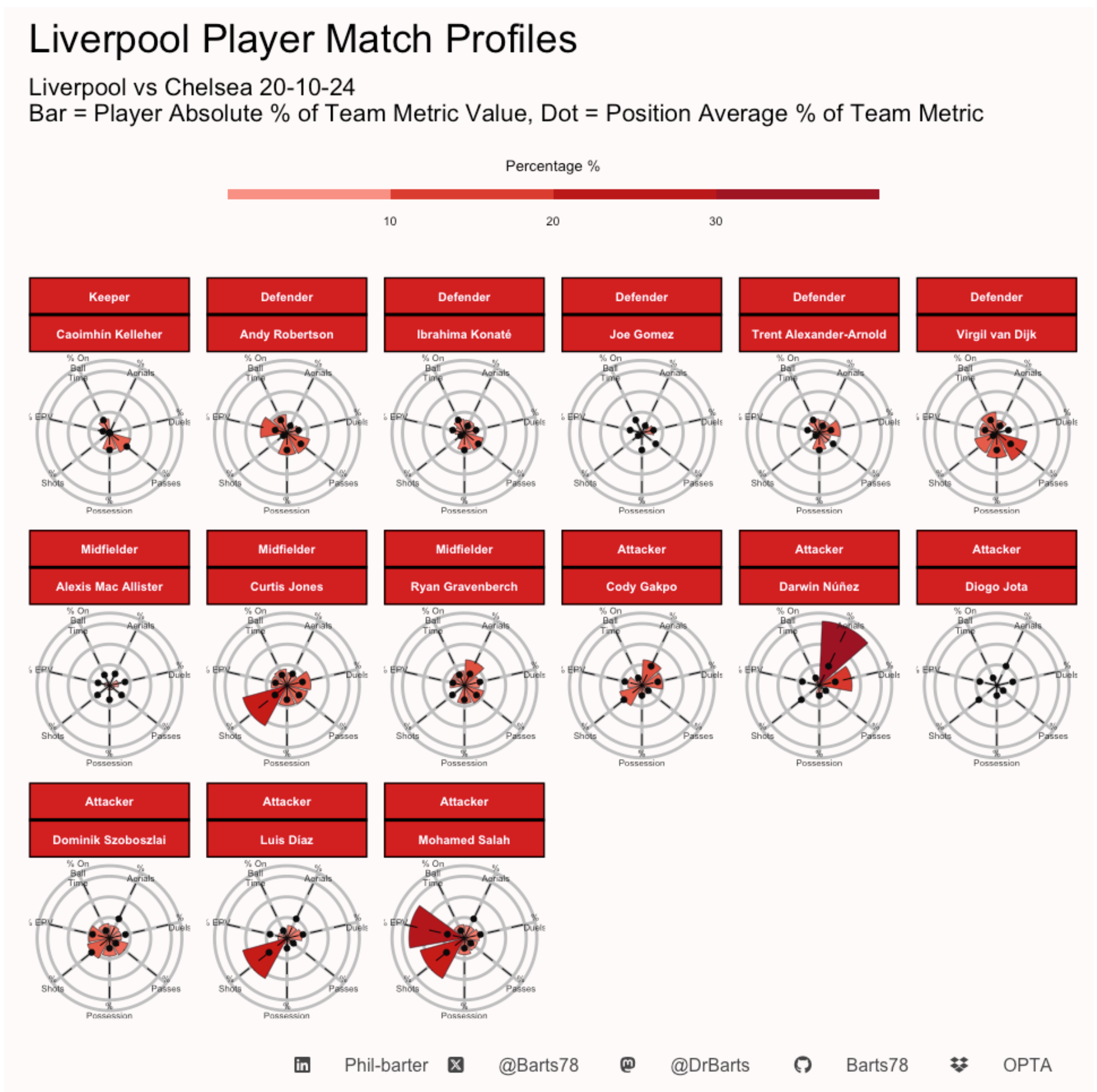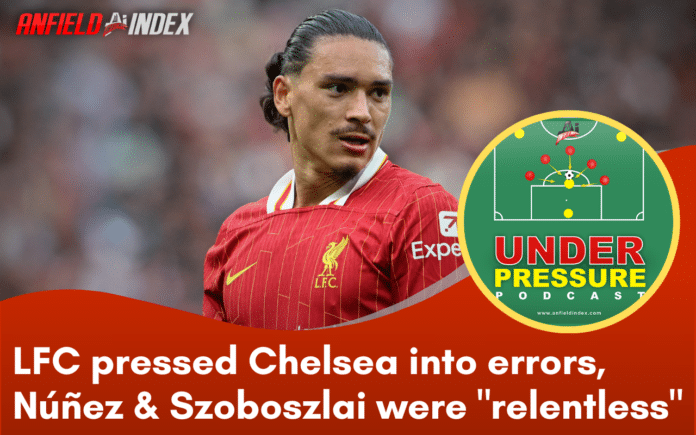Liverpool’s Tactical Masterclass vs Chelsea: A Game of Control and Efficiency
Liverpool’s 2-1 win over Chelsea at Anfield was more than just a hard-fought victory. As expertly analysed on the Anfield Index Under Pressure podcast, the match provided a tactical showcase, where the Reds managed the game state to perfection, outclassing a possession-heavy Chelsea side. With a mixture of defensive resilience, efficient attacking, and relentless pressing, Arne Slot’s team once again demonstrated why they are among the Premier League’s best at controlling key moments.
Game State: Control Without Dominating Possession
A key theme discussed on the podcast was how Liverpool managed the game state despite Chelsea having more of the ball. Dan Kennett emphasised that possession numbers can be misleading: “Chelsea had 55% possession, but we converted nearly 150% of our expected goals (XG), while they only converted 45%. That’s the difference.”
Liverpool’s approach was not to dominate the ball but to make their possession count. Darwin Núñez stood out as a prime example of efficiency, playing a pivotal role in both attack and pressing. The chart below shows Núñez’s significant contribution to shots and pressing, underlining his importance to Liverpool’s transition from defence to attack.

Curtis Jones, Alexis Mac Allister, and Ryan Gravenberch were also crucial in this setup. Jones, in particular, was singled out for his best performance in a Liverpool shirt. Simon Brundish said, “Curtis had his best game for Liverpool; he was central to everything, both in possession and out of it.” Even with Liverpool conceding the majority of possession, the team’s high-impact approach in critical moments won the day.
Defensive Discipline: Shutting Down Chelsea’s Threats
One of the standout features of the match was Liverpool’s defensive resilience. The chart below reveals how the Reds concentrated their defensive actions in key areas, especially down the left side, where Andy Robertson and Virgil van Dijk were particularly busy. Dr. Phil Barts pointed out, “Robertson had 10% of our defensive actions, which tells you how much we were willing to let Chelsea play in wide areas, knowing we could deal with it.”

Despite Chelsea’s 721 touches—significantly more than Liverpool’s 576—the visitors were restricted to just two shots on target. As Kennett explained, “Our defensive structure didn’t allow Chelsea to create high-quality chances, and they were mostly limited to low-threat areas.”
The heatmap also underscores Liverpool’s focus on protecting central areas, with the majority of Chelsea’s possession failing to penetrate the danger zones around the penalty box. Barts added, “We had 10% of our defensive actions in the left-back zone, and that shows how much Robertson and Van Dijk were able to control that side of the pitch.”
Pressing Power: Núñez and Szoboszlai Lead the Charge
Another key point of analysis on the podcast was Liverpool’s pressing, led by Darwin Núñez and Dominik Szoboszlai. Hamzah Khalique-Loonat described them as “pressing monsters,” explaining how their energy off the ball forced Chelsea into rushed passes and mistakes.
“Núñez in particular was relentless,” said Hamzah. “He put their backline under constant pressure, forcing them to go long or make errors.” This was supported by Liverpool’s long ball rate, which at 15%—the highest of the season—highlighted their tactical choice to bypass Chelsea’s midfield press when necessary. According to Barts, “We were launching the ball from deeper positions to disrupt Chelsea’s control in the midfield and force them to chase the game.”
Szoboszlai’s pressing was another standout, with Kennett adding, “His pressing numbers were phenomenal. He was a big part of why we could force Chelsea to give up possession in dangerous areas, allowing us to break quickly.”
Curtis Jones vs Cole Palmer: A Tactical Battle
One of the most intriguing aspects of the game was the battle between Curtis Jones and Chelsea’s in-form midfielder, Cole Palmer. Despite Palmer being one of Chelsea’s most dangerous players this season, Jones largely kept him quiet. Brundish highlighted this matchup, saying, “Curtis completely nullified Palmer. It’s one of the few games this season where Palmer couldn’t really influence the match.”
Hamzah agreed, pointing out the evolution of Jones’ game: “Curtis was everywhere—tracking, pressing, and even shielding the ball in deep areas. He’s come a long way from the attacking midfielder he used to be. Klopp and Slot have moulded him into a player who can control midfield battles.”
Jones’ transformation was a key focus of the podcast, as Brundish remarked, “Five years ago, Klopp asked Jones to focus on his weaknesses, and we’re seeing the results now. He’s become crucial to how we control games tactically.”
Even though Palmer has been one of the Premier League’s standout players this season, he found it difficult to make an impact against a disciplined and physically dominant Jones. “Palmer couldn’t cope with the physicality,” said Kennett. “It was clear that Curtis was ready for the duel, and he came out on top.”
Dr Barts Stat Pack: Liverpool 2-1 Chelsea
Game Management: Seeing Out the Last 40 Minutes
After taking the lead, Liverpool expertly managed the game for the remaining 40 minutes, limiting Chelsea to very few dangerous moments. As Brundish pointed out, “Once we took the lead, it was about managing the game. We didn’t allow them back into it, and that’s a testament to the team’s maturity.”
Kennet further elaborated on how Liverpool controlled the match after going ahead: “We limited them to just one big chance after going 2-1 up, which shows how disciplined we were in the second half.”
In contrast to last season’s chaotic defending, Liverpool’s organisation and tactical maturity were on full display. Barts observed, “Our pressing and defensive structure in the last 40 minutes was spot on. We weren’t just sitting back—we were proactive in preventing Chelsea from gaining any momentum.”

Liverpool’s 2-1 win over Chelsea wasn’t just about individual brilliance; it was about tactical execution, game management, and a team that knows how to handle key moments. The detailed breakdown from the Anfield Index Under Pressure podcast showcased how Liverpool’s blend of pressing power, defensive resilience, and ability to control the game state allowed them to overcome a possession-heavy Chelsea side.
With standout performances from Curtis Jones, Núñez, and Szoboszlai, and Slot’s tactical adjustments proving decisive, this Liverpool team continues to demonstrate that they can adapt to any challenge thrown their way. As Brundish summed up, “It’s not always pretty, but it’s always effective—and that’s what counts in a season like this.”




